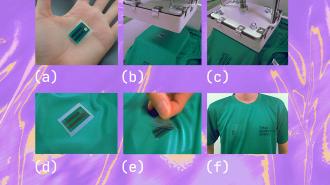Your sweat can tell you a lot about your body’s inner chemistry. By monitoring the concentration of chloride ions in your sweat, you can get an accurate picture of your body’s overall balance of vital electrolytes, and even detect health problems including dehydration, heat stroke, and low sodium levels before they get out of hand.
Recently, researchers have begun to develop chloride ion sensors which can be worn directly on the skin, and allow users to monitor their levels of chloride ions in real time. However, the technology still has a ways to go to become commercially available.
The challenge: Today, chloride ion sensors are often uncomfortable and irritating to wear, especially when the sensor becomes saturated with sweat. In some cases, the sensor’s synthetic materials even risk causing allergic reactions.
One clever solution is to integrate sensors directly on top of our clothing, separating them from the skin. But because textiles (cotton, polyester, wool, etc.) are often bumpy and irregular, this approach tends to make their readings far less accurate.
The new sensor is completely separated from the wearer’s skin.
Printing on textiles: Now, a team of researchers in Japan have developed a new approach for fabricating chloride ion sensors on top of clothing, while maintaining their accuracy.
In a new study published in ACS Sensors, a team led by Isao Shitanda at the Tokyo University of Science turned to a technique named “heat transfer printing,” which is used to print graphic designs onto clothes (and sometimes even skin).
The researchers printed their sensor’s electrodes inside a protective coating, backed with an adhesive. The device was first printed onto a removable polyester film, then bonded to the textile under high heat and pressure, using a heat press.
This way, the sensor could be firmly and evenly bonded to several different types of textile – t-shirts, wristbands, even shoe insoles — while fully protecting its delicate electrodes from the heat press.
The sensor’s real-time measurements matched closely with measurements of users’ saliva.
Protecting the skin: The team’s sensor is completely separated from the wearer’s skin, preventing any risk of irritation or allergies. As it absorbs sweat, wicking effects in the textile help the chloride ions spread evenly between the sensor’s electrodes, ensuring a reliable and accurate reading, which can then be transmitted wirelessly to a phone or computer.
Shitanda’s team tested their design on a human volunteer, who worked up a sweat by riding on a static bicycle for half an hour. As they hoped, the sensor’s real-time measurements of the participants’ chloride ions matched closely with measurements of their saliva – which also responded strongly when they varied the intensity of their exercise, causing them to sweat more heavily.
Optimising your workout: Based on this performance, the researchers are now hopeful their sensor design could soon become affordable and widely accessible, with uses including more personalised healthcare plans for people with conditions that make them vulnerable to heat stroke or dehydration.
Elsewhere, the sensor could be attached to sports clothes to optimise their wearer’s workout schedules, while helping them to stay healthy and hydrated.
We’d love to hear from you! If you have a comment about this article or if you have a tip for a future Freethink story, please email us at [email protected].





